The chronic Mopar misfortune held steady through the ’70s. In 1974, all their new full-size C-bodies, from the Plymouth Fury to the Imperial LeBaron, were redone with more formal and Broughamier sheetmetal. Although not drastically different size-wise from their fuselage predecessors, they looked bigger. And when the gas crisis hit in late 1973, just as the ’74s were debuting, Chrysler got screwed–again. Despite the company’s continuing bad luck, all their new models were attractive despite styling cribbed directly from GM–something especially noticeable in the Plymouth Fury’s Oldsmobile 88 cues, and in the Dodge Monaco, which looked suspiciously like a 1973 Buick LeSabre.
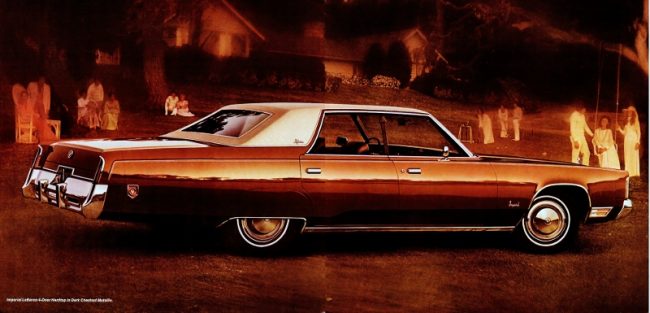
At the top of the heap was the C-body full-size Imperial LeBaron, arguably the most attractive car of the bunch–as well it should have been, considering its premium $7,200-7,800 pricing. The Imperial’s 124″ wheelbase was the same as lesser New Yorkers and Newports, but the car itself was longer overall and featured exclusive hidden headlights; button-tufted upholstery, in velour or optional leather; and four-wheel disc brakes.
But it didn’t sell: After selling just 14,483 1974 models and a mere 8,830 ’75s, the Imperial finally left the building. Well, until 1981, but that’s a story for another time.
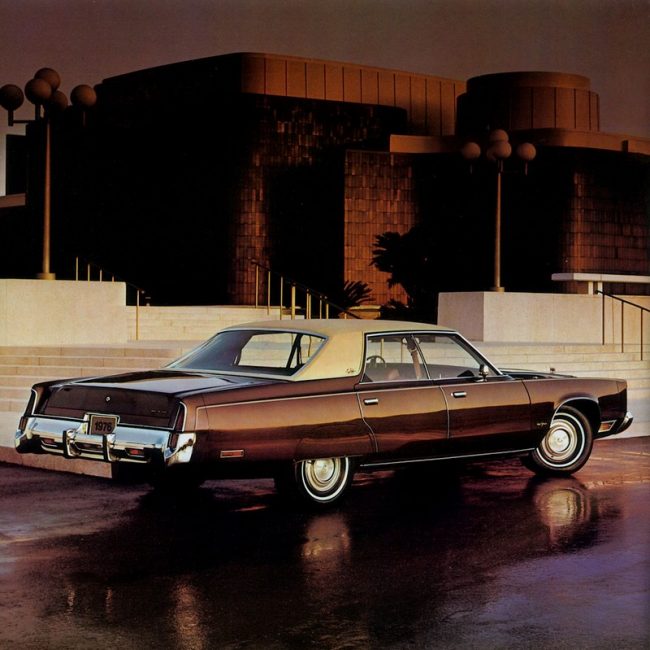
For the car did reappear–prominently displayed on the cover of the 1976 Chrysler brochure. An Imperial no longer, but a New Yorker Brougham. In reality, it was the plain-Jane Newport that had been discontinued for 1975. All the other Chrysler nameplates got either an upgrade or a downgrade depending on the model: The ’75 Newport Custom was now the ’76 Newport; the ’75 New Yorker Brougham became the ’76 Newport Custom; and the ’75 Imperial LeBaron was the ’76 New Yorker Brougham.

Confusing? You bet, but Chrysler was strapped for cash and this was the best they could do at the time. And don’t forget that the midsize ’74 Satellite became the 1975 “small Fury”, as biggie ’75 Plymouths all wore the Gran Fury moniker! With these changes added to the ’76 Coronet becoming the “new” midsize ’77 Monaco (all big Dodges became Royal Monacos in ’77; the RM moniker debuted as the top big Dodge in ’75), Mopar shoppers likely got a headache trying to figure out what was what.

Strangely, it worked, at least for the big Chrysler. The ’76 NYB, still available in coupe and sedan models, sold far better than the ’75 Imperial, and Chrysler likely laughed all the way to the bank. The Chrysler-ized Imperial was a bit less well-equipped than the Imperial had been–the four-wheel discs reverted to front discs/rear drums, for instance–but customers didn’t seem to care. In fact, despite the lower price of the NYB, many probably sold for Imperial money, since most buyers wanted all the power options that had been standard on the Imperial and now cost extra.

Chrysler did attempt to cheap out on the 1977 model. The super-deluxe “lawyer’s desk chair” upholstery that had been standard on all ’76s became an option in ’77. The standard ’77 interior, shown above, was just not as snazzy for a car with the New Yorker Brougham mantle. The Newport-like interior disappeared almost as fast as it came, and once again the ’78s were equipped with button-tufted goodness as standard equipment.

Nineteen seventy-eight was the last year for the big New Yorker. Chrysler’s lineup was shrinking–the Dodge Royal Monaco, Plymouth Gran Fury, and Chrysler Town & Country wagon had all disappeared at the end of 1977–but you could still get a big, “luxy” Chrysler, by golly!
Along with the Cadillac Eldorado, Oldsmobile Toronado, Ford LTD/Mercury Marquis, and the Lincoln Continental and Mark V, it was one of the last no-compromise full-size cars on the new car market.
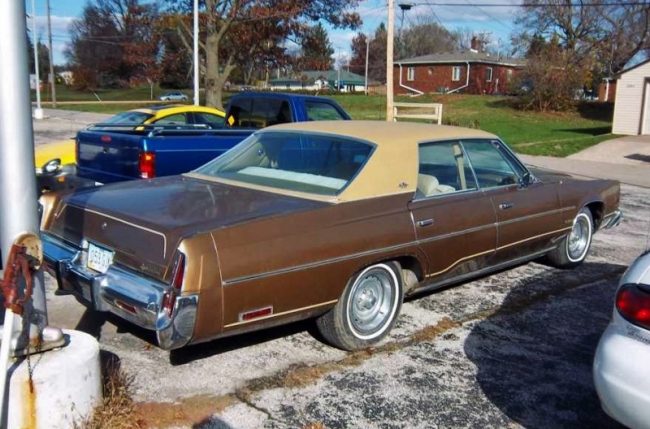
Not too much was new in its final model year, but you could tell a ’78 by its revised waterfall grille and pinstriping along the lower swag line. It was also a milestone car of sorts, as it and its Newport sibling were the last pillarless hardtops made-at least in the USA.
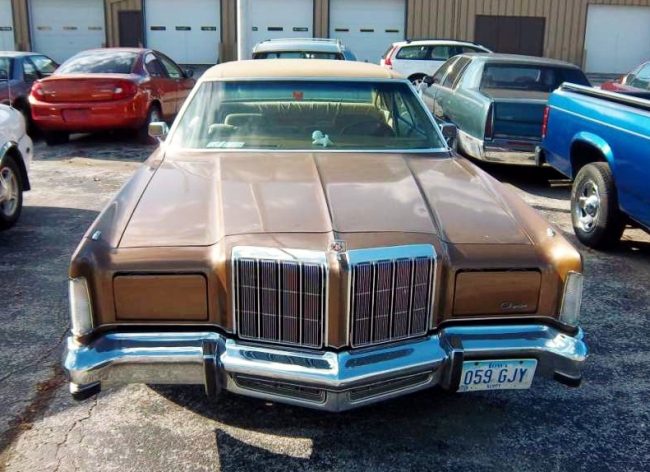
As you would expect, the New Yorker Brougham had many standard features. For starters, they got Mopar’s biggest, baddest engine: The 440 CID (7.2-liter) V8 engine with a four-barrel carburetor and TorqueFlite. Other expected amenities included power windows, power brakes, power steering, velour 50/50 bench seating and shag carpeting. The trunk was also carpeted, and each door save the driver’s got its own ash tray and lighter. It was a different time.
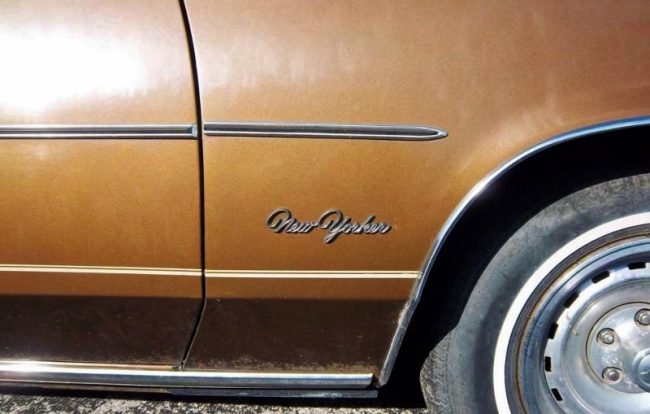
Plenty of chrome trim was in evidence with wheel moldings, drip rail moldings, a stand-up hood ornament and gold-tone New Yorker script on each front fender and the tail panel. The very handsome Road Wheels were optional, but whitewall tires were standard equipment.
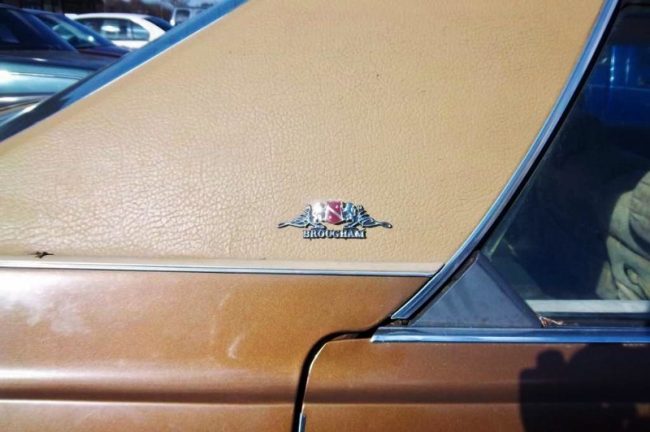
A vinyl roof cover was also standard, at least on the NYB; on Newports, it was an option. I’ve always loved this little curve in the C-pillar of the Imperial/NYB sedans–just a little hint of Hooper-bodied Rolls Royce, and a nice touch of class. Indeed, the whole car was pretty classy. One of these in black with a black vinyl top, white leather upholstery and red carpets would be my dream car. Oh, and don’t forget the 15-inch Road Wheels!
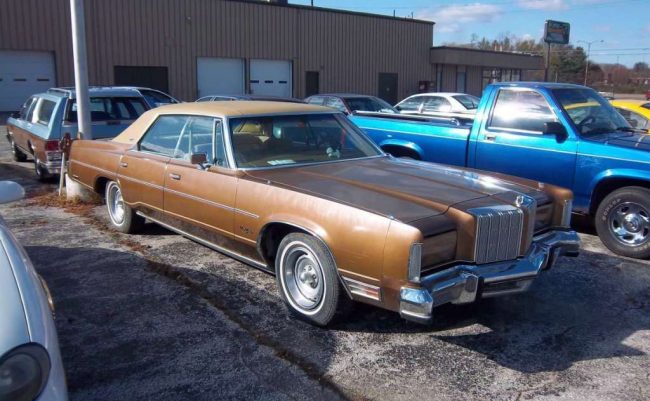
I had noticed what appeared to be a 1974-75 Imperial in the parking lot of a local business several years back, in west Davenport. Finally, my curiosity got the best of me and I pulled over for a look. It was not an Imperial, but a ’78 New Yorker Brougham four-door hardtop, in Golden Fawn with a beige top and beige velour–a very ’70s color combination. And quite attractive, in your Brougham-obsessed author’s opinion.
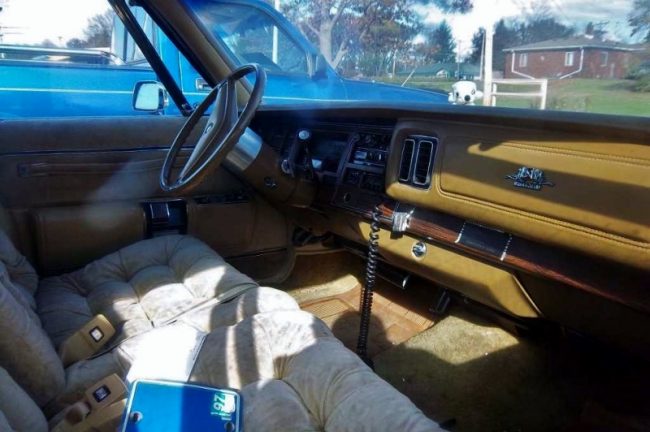
The interior was suitably plush for a late ’70s domestic luxocruiser. Unlike its Cadillac and Lincoln competitors, the instrumentation was not limited to just a gas gauge and speedometer; it also included engine temperature and alternator gauges. Although a far cry from its 1940s-1960s engineering heyday, Chrysler still had some thoughtful “right brain” touches, including the aforementioned gauges, the bullet-proof TorqueFlite transmission and torsion bar front suspension.
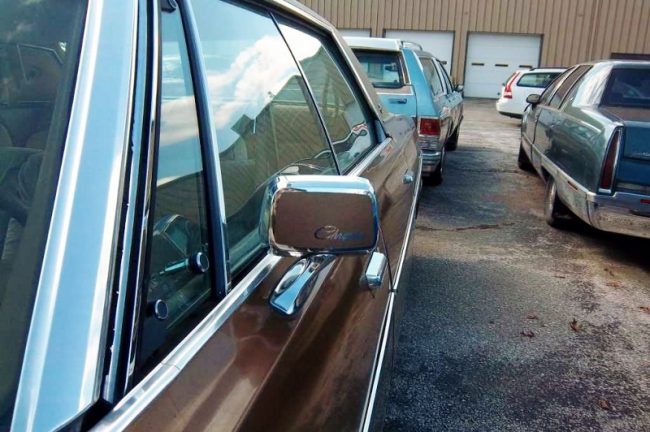
The full-size Chryslers were also among the last to offer vent windows, albeit optionally; the last of the C-body Royal Monacos and Gran Furys had them as well. All too soon though, they would be gone for good, save for the power vent windows found on Ford products well into the late ’80s. I remember that my grandmother’s Rose Quartz 1987 Continental had them. So did the navy blue 1977 Mark V before it.
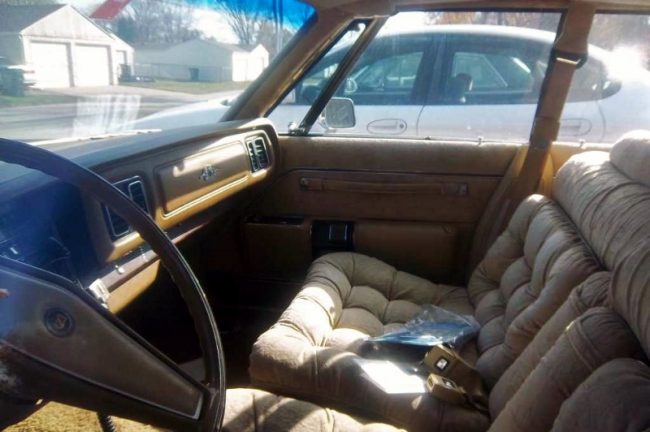
Here’s that Broughamtastic front seat. Not only was the seat split 50/50, but each passenger got their own fold-down armrest. This car also appears to have an optional CB radio, though I don’t recall if it was the AM/CB or AM/FM/CB system. Considering all the options on this not-inexpensive car, I would guess it’s the AM/FM version with four speakers.
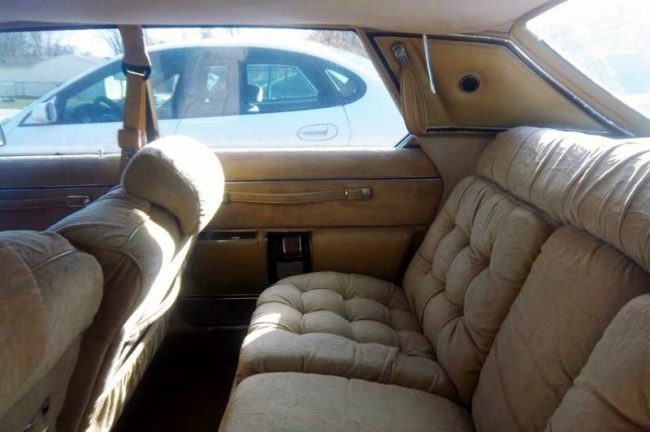
Here’s the back seat. This is totally an American Brougham Society-approved interior, the kind of seat where you could lose not only pocket change but your entire wallet. And maybe a hat. Four-door models included lavaliere straps (seen above), and both the coupe and sedan had pillows–yes, pillows–built into the C-pillar.
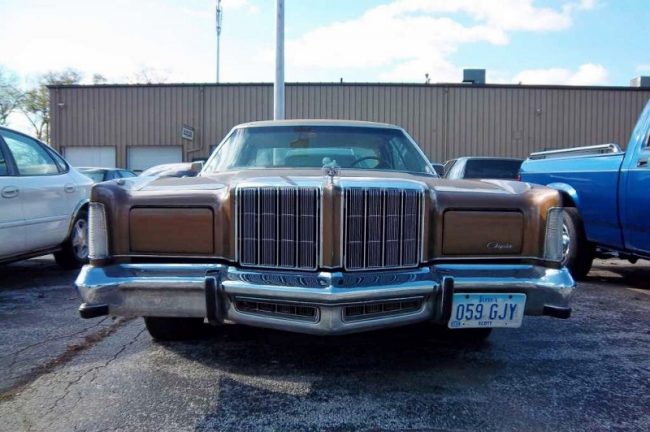
Yes, the NYB was a lot of car for the money, but times were changing. Cadillac had already shrunk their Fleetwood and de Ville models in 1977; in 1979, Chrysler did the same with the New Yorker and Newport; and Lincoln was last to the small-big-car party, with their 1980 Panther-based Continental and Mark VI. It was truly the end of an era.
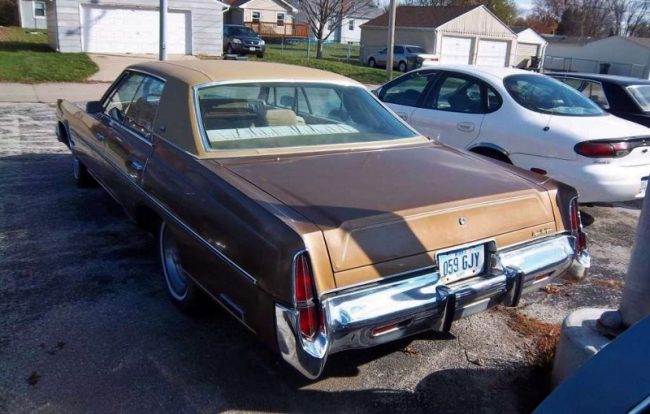
As for the New Yorker, although it reinvented itself many times over the next two decades–from downsized R-body to mid-sized M-body to shrunken K-car Broughamette to luxury LH–it always had at least a modicum of style and comfort. It lives on even today, in a fashion, as the premium 300 sedan. Considering the 300 series was originally a sportier replacement for the Saratoga, I can’t help but wonder why a LWB New Yorker variant hasn’t come out. After all, nothing says big American luxury car like “Chrysler New Yorker.” Its reputation was built on yachts like this ’78.
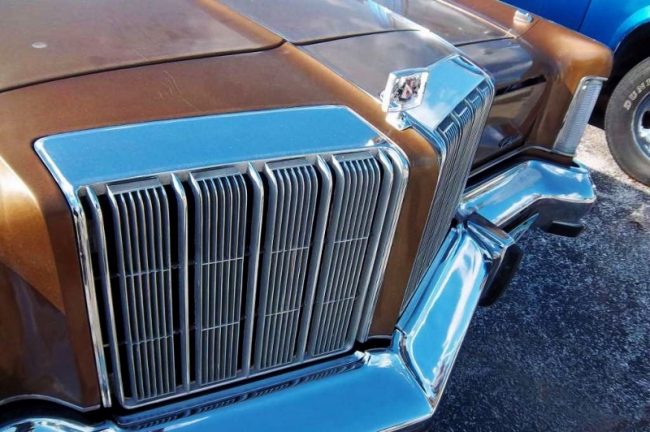








9 Comments
I agree with you that Chrysler should have variants of the 300. I’m not going to pay for a top dollar 300 with virtually same look as lower levels. I would have paid top dollar for a New Yorker or Imperial name in the car with all the best luxury. Currently own Genesis G80.
A lovely survivor .
-Nate
Chrysler’s problem was they didn’t have a budget to support so many brands, so they all ended up looking about the same and sharing the same engines, transmissions, etc. How was a Dodge better than a Plymouth, or an Imperial better than a New Yorker? By the late 1960s it was pretty difficult to answer those questions in a way that would shift buyers to the pricier and more profitable brands and models. And Chrysler certainly didn’t have a budget to create a small car, which would not have made money anyway with the relatively low volume and expensive UAW labor – if GM couldn’t make a decent profit on a Vega, Chrysler certainly wouldn’t on a competitor with half the volume, so they really suffered with their gas guzzler line-up during the 1970s fuel crises that took away the volume sales on the full-size cars that made all their profits. Ironically FCA has the same problem today – too many brands and too few sales and profits to keep them all fresh and desirable, together with a total financial reliance on Jeeps and Ram pickups whose sales are dependent on gas and interest rates staying cheap. Lee and US taxpayers rescued Chrysler in the late 1970s, and Fiat and the US taxpayers rescued them again in 2008, who will rescue them during the next crisis?
I had a 1977 one of these, silver with the non-pillow cloth interior, still very comfortable, best damn $400 car that ever came down the pike. Bought it with 4 brand new Michelin’s on it, that was almost the $400 right there. She was traded in a new Cadillac at Williamson Cadillac and bought by a wholesaler who brought it over to our dealership to try to sell it to one of the porters, a black guy named Willie, but Willie was brand loyal and he didn’t want “no damn Chrysler….he wanted a Caprice or a Deuce!”
So Willies loss was my gain. Mine had a 440 that had been “de-lean burned” and she ran like champ, still had cold a/c and working cruise. There was a big manilla file folder under the front seats with service documents dating back to 1980 and a copy of the window sticker, about $10,000, she was sold new at Key Chrysler-Plymouth in Ohio.
Everyone thought it was a Lincoln……
A heck of a lot of car for less than 10 cents per pound.
“Gimme a pound of whatevers going bad!”
Funny, I never felt that these Imperial/New Yorkers could match the comparable Lincoln/Cadillac interior quality. Despite the seats, the door panels, dash design and plastics just didn’t do it for me. Impressive car, though.
It was quite confusing in the Fall of 1974 when the changes were announced to the whole Chrysler family line up. Fury was a midsizer? What’s this Gran Fury thing? What made it so Gran? What was Gran were the New Yorkers and the remaining Imperial. But back at that time, the focus was fuel mileage, at least for most folks.
We had no idea what was about to hit us, between CAFE and the next Oil Crisis in 1979. For a time in the mid-1970s people were getting back to normalcy, at least the one they thought existed before 1973. The writing was already on the wall in the late 1970’s and blunderbusses like these sedans were on their way out. Up until recently I would have argued that we lost little, but now I’ve changed my mind and agree with others that we’ve lost a lot.
With the relative price stability we’ve had for fuel for a little over a decade now, I can see inklings of folks wanting to return to big, I mean BIG cars. Not everyone wants their big car to be a truck. OTOH, the industry is not keyed to making a car like this again, so maybe these behemoths will be cherished again. I certainly hope so.
Thanks for posting a thoughtful article on these great cars. I have a 1978 New Yorker Brougham coupe with the St Regis package and 440. I own a few Cadillacs and a 69 Continental and this Chrysler is really a treat, even compared to those. The 440 is de-smogged and the combination of power, ultra-light steering and soft-but-controlled handling with the torsion bars is just amazing. Until the harsh realities of the 80s set in, you could tell that the C-body was the car Chrysler cared about the most. You can trace the lineage back to 1960 when the unibody and wedge engine came out. Before the muscle car era, the fast car of the line was a big expensive car, like a multi-carb Eldorado or a letter-series 300. With some mild tuning, these New Yorkers are the last of the “Businessman’s Express” concept. It’s a luxury car that can drive with the best of them as it swaddles you in pure comfort. They may have faster cars today, but no car so comfortable or beautiful as one of these. I wish everyone could drive the Brougham once in their life, just to see the grandeur that was available to the slightly-above-average American.